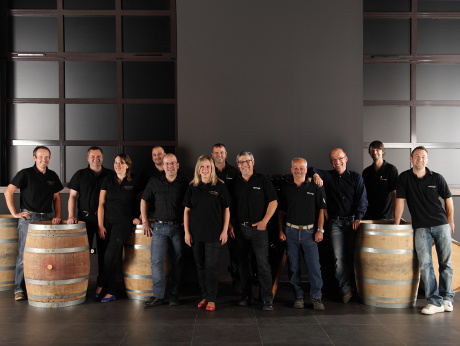
Blending, a quest for wine profiles
After the harvest, when vinification is coming to an end, vats containing only one varietal are chosen for their taste and smell profiles and according to the types of wine we’re looking to make.

Alcohol and residual sugars
During the alcoholic fermentation, the yeast transforms the sugars of the grape must into alcohol. On average 16.83 grams of sugar are needed to form one degree of alcohol. Depending on the types of wines to be made and the alcohol potential of the grape must, fermenting can end when the yeast has depleted the supply of sugar or simply when the oenologue decides. That decision could be taken to retain the residual sugars and avoid having a high degree of alcohol in the wine, thus getting a sweeter wine which is perfect, for example, for the Gewurztraminer. Depending on the varietals, their appellations and special features (Vendanges Tardives, Sélections de Grains Nobles), minimum and maximum limits of alcohol and residual sugars have to be met so the wines conform to the specification sheets of the different appellations. To make a dry wine, the vats chosen would have a low level of residual sugar.
Sense qualities and colors
In the nose, the main aromas from the grape along with the secondary aromas that come from the fermentation and the ground (where they’re planted) go to make the aromatic profile of a wine. So the wines will be blended depending on their profile and the kind of wine we’re looking for. On the palate, the balance between sugars and acids will also be a condition for choosing which vats to blend. Primordial for our Pinot Noir red and rosés, this parameter is secondary for the white wines. The color potential present in the red grape skins increases little by little in the pulp as it ripens. The ripening of the skins in the pulp is essential for making red wines but must also be judged in making rosés.
Acids
The grapes contain malic acid (like most fruit) but also tartaric acid, which is more characteristic of grapes and certainly one of the reasons that inspired man to elaborate a beverage (wine) by fermenting grape juice. The tartaric acid is biologically much more stable than malic acid, which can be weakened by bacteria during the malolactic fermentation. The malic acid diminishes significantly during the ripening, the same as an apple that becomes less acid as it ripens. This is important to the typicity of a wine, and will be a parameter for choosing which vats to blend. Crisp and biting acidity is actually sought after in wines made from Riesling, Pinot Blanc or even Sylvaner grapes, while that liveliness isn’t as necessary in the Gewurztraminer or the Pinot Gris.




